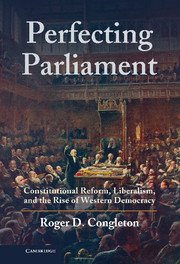Book contents
- Frontmatter
- Contents
- Preface
- 1 On the Origins of Western Democracy
- Part I Sharing Sovereignty
- 2 Team Production, Organization, and Governance
- 3 Organizational Governance in the Long Run
- 4 The Origins of Territorial Governance
- 5 Constitutional Exchange and Divided Governance
- 6 The Power of the Purse and Constitutional Reform
- 7 Suffrage without Democracy
- 8 Ideology, Interest Groups, and Adult Suffrage
- Part II Historical Evidence on Western Democratic Transitions
- Part III Analytical History as Social Science
- Appendix Methodological Approach, Limits, and Extensions
- References
- Index
5 - Constitutional Exchange and Divided Governance
Published online by Cambridge University Press: 05 June 2012
- Frontmatter
- Contents
- Preface
- 1 On the Origins of Western Democracy
- Part I Sharing Sovereignty
- 2 Team Production, Organization, and Governance
- 3 Organizational Governance in the Long Run
- 4 The Origins of Territorial Governance
- 5 Constitutional Exchange and Divided Governance
- 6 The Power of the Purse and Constitutional Reform
- 7 Suffrage without Democracy
- 8 Ideology, Interest Groups, and Adult Suffrage
- Part II Historical Evidence on Western Democratic Transitions
- Part III Analytical History as Social Science
- Appendix Methodological Approach, Limits, and Extensions
- References
- Index
Summary
The theory of territorial governance developed in the previous chapters provides an explanation for the existence of territorial governments, why they tend to be rule driven, and why we rarely observe a ruler without an advisory council or a ruling council without a chief executive officer. It also explains why every government tends to have its own relatively stable law of the land and why that law will not generally be the same for all members of the communities ruled. The rules are partly informal (or spontaneous) and partly the result of conscious efforts to adopt and enforce polices that advance organizational interests and, more specifically, the interests of formeteurs and their successors.
To say that governments are constrained by the advantages of stable rules and their own institutional conservatism does not mean that the policy-making procedures and policies of governments are entirely static. Many persons inside governments will have some discretion to make informal adjustments to standing policies at the margins. Moreover, the core procedures of governance may be modified when reforms appear to be useful – that is, when amendments appear to benefit the members of the organization’s rule-making bodies.
- Type
- Chapter
- Information
- Perfecting ParliamentConstitutional Reform, Liberalism, and the Rise of Western Democracy, pp. 97 - 113Publisher: Cambridge University PressPrint publication year: 2010



